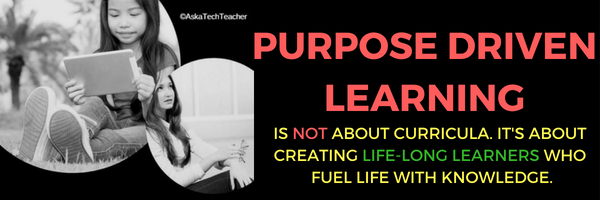 For the 45 states who opted into Common Core, using technology in the classroom is no longer a choice–it’s required. Common Core’s Standards insist that for any student to be prepared for college and career requires they be digitally- and technologically savvy. From the English Language Arts Standards:
For the 45 states who opted into Common Core, using technology in the classroom is no longer a choice–it’s required. Common Core’s Standards insist that for any student to be prepared for college and career requires they be digitally- and technologically savvy. From the English Language Arts Standards:
Technology differentiates for student learning styles by providing an alternative method of achieving conceptual understanding, procedural skill and fluency, and applying this knowledge to authentic circumstances.
…and from the Math Standards:
Mathematically proficient students consider the available tools when solving a mathematical problem. These tools might include pencil and paper, concrete models, a ruler, a protractor, a calculator, a spreadsheet, a computer algebra system, a statistical package, or dynamic geometry software. Proficient students are sufficiently familiar with tools appropriate for their grade or course to make sound decisions about when each of these tools might be helpful.
The standards themselves go into detail. Sprinkled throughout are constant allusions to the importance of using technology, its fundamental nature as the bedrock of education, and the necessity to weave it throughout the academic fabric, regardless the topic, skill, or requirement.
Here are thirteen reasons why this is a good idea. The first seven are directly from the Standards, the last six from classroom experience:
- Allow students to demonstrate independence–Tech makes it easy to provide options for accomplishing goals. Consider: a book report delivered with Voki, Prezi, Glogster, a video. Students make a decision as to which approach is best suited to their communication and learning style.
- Enable students to build strong content knowledge wherever they find it–It’s easy for students to pursue anything they’re curious about with technology. Make available online dictionaries to quickly look up unknown words. Teach students the tricks of quick and accurate online research. Follow the lead of hundreds of schools nationwide who have added the Genius Hour to their curriculum where students follow school academic guidelines 80% of the time and get to follow their own passion for the remaining 20%.
- Respond to the varying demands of audience, task, purpose, discipline–decode this critical concept early in the education year. Explain why audiences are different–as is task, purpose and discipline–and how communication methods need to adapt to those variances to succeed. Then, let students pick what works, be it audio, visual, textual, color/movement, or a polyglot of their own making.
- Value evidence—with technology, students can click through to primary documents for evidence in support of their argument and push back if they don’t find those connections. Is the information believable if they can’t evaluate source material? What if it was misinterpreted? Teaching students to read closely, think critically, and dig deeper is easier with technology.
- Understand other perspectives—Sure, this can be done through conversation and class presentations, but doing it through blogging, comments, discussion boards—aka, technology–is bigger. Plus, as students share their perspective, they can edit and rewrite to be sure the words fully reflect their ideas.
- Differentiate for needs of students–nothing does this better than technology. The creative student can use art and music. Those who love words can write. Visual learners can use a combination of color, images, and personal drawings.
- Deep learning by using resources students are interested in—If we do our job well, students are inspired to learn more. They are eager to dig deeper into what has sparked their scholastic interest. If that means getting a ride to the library, going to the bookstore for a book, arranging tutoring time with a knowledgeable teacher, they may never get to it. If resources are only a click away, the chances increased—may even become fun. Share these enrichment materials through Google Apps for Education, post links through a class link page (like a class internet start page or Diigo account), create a playlist through programs like MentorMob.
- Common Core expects students to be active learners, authors, not just consumers–Technology makes that happen by asking them to publish, share, collaborate.
- Students want to use technology—Using iPads, Chromebooks, laptops, widgets, online tools, and a plethora of other digital devices, technology provides a path to learning that students are eager to follow. Why ask them to unplug at the schoolhouse door?
- Technology is its own assessment tool–to paraphrase James Paul Gee, a Professor of Literacy Studies at Arizona State University): “When students use simulations, games, videos to learn, they have to problem-solve, critically think, transfer knowledge from other learning experiences.” That’s a good thing.
- Learning with technology is connected–In a connected, technology-rich environment, students engage with peers, celebrities, relatives, and experts worldwide. They like to do that. Why do you think social media is so viral?
- Technology gives students an equal voice–Student value is in what they produce, not based on age or grade-level. Their voices are important; they are listened to. If they publish an ebook, it is judged on the quality of writing, not their age. Where else can this happen?
- Consider a video—for teaching, that is. Students can pause it, rewind, learn at their own pace. That’s technology.
Do 13 reasons offset the three most popular excuses for not using technology:
- How does it fit into my program
- I’m already juggling too much
- I don’t have time to learn it or use it
Sheryl Nussbaum-Beach once said, “Teachers will not be replaced by technology, but teachers who don’t use technology will be replaced by those who do.” Amen.
If you don’t use technology in the classroom–or wish you didn’t have to–share your reasons.
Jacqui Murray has been teaching K-18 technology for 30 years. She is the editor/author of over a hundred tech ed resources including a K-12 technology curriculum, K-8 keyboard curriculum, K-8 Digital Citizenship curriculum. She is an adjunct professor in tech ed, Master Teacher, webmaster for four blogs, an Amazon Vine Voice, CSTA presentation reviewer, freelance journalist on tech ed topics, contributor to NEA Today, and author of the tech thrillers, To Hunt a Sub and Twenty-four Days. You can find her resources at Structured Learning.





































Your article is spot on. I love using technology but continually come up against educators who believe they have a valid reason not to integrate technology effectively – they say they don’t have the time or they need more PD. I have learned most of my technology skills from playing with a Web 2.0 tool or program and just having a go. Teachers need to be more independent in their technology learning and invest their time in their own personalised learning. Maybe even learn from their students.
This is true. There is no end to the reasons NOT to use tech. Another I love is that it doesn’t always work. Yes, that’s true. And neither do pencils or note paper (that gets lost or wet). I’m not belittling the reasons. Just that at some point, we have to move forward. Teachers as a group are amazing and I know they will!
I have been enjoying your blog..thanks for sharing your knowledge, love the posts. I have been learning a great deal. Thanks again, One Love One Heart
My pleasure, Angela.
Love it
Thanks, Joshua
After unremitting research I have observed more than enough on Technology in the classroom,however there must be some who opposes.
Unfortunately, I think that train has left the station. Technology is here to stay in education. It’s up to us to figure out how to make it work.
Good news is that what you think isn’t necessarily fact. In my own observations, technology has hurt students more than it has not. I have noticed a considerable drop in attention and retention. When a student is asked what they have learned or what was taught, they remember the vibrance of the application or something that distracted them on, say, an iPad or Chromebook and not what was being taught.
On a different note, I think that a traditional classroom can happily coexist in a world where technology classrooms are dominate, if it must.
Lots of what you say I don’t disagree with, Edward. The problem is that toothpaste is already out of the tube. Kids want to learn with technology and are doing so pretty much everywhere outside of school. Our challenge is to deliver it in ways that solve the problems you mention.
The main reasons not to use “modern technological gadgets” in schools are: 1. This technology is not being created and marketed to help us in becoming better humans (no altruistic reasons), but rather to increase the monetary wealth and power of already giagantic corporations. The full spectrum of consequences of having and using these gadgets regularly has not been completely investigated, and the negative aspects and consequences that are known are downplayed and buried under MASSIVE societal propaganda- seeded by the tech giants. 2, Failure to link the economic system of capitalism and global market trade with “industrial advance” and now with “technological advance” is a HUGE FAILURE- as this perversly materialist economic system is largly responsible for global ecological crisis, human exploitation and manufactured divisions (1st/3rd worlds), wars, racism and a host of other individual and social ills. It is up to educators today to recognize this and help LEAD the youths in the correct manner- NOT what is being SOLD to them and all of us.
Thanks for this. I do fear this ship has sailed. I don’t know that will undo what’s already been done.
where are the negatives
Hi Sky–they’re toward the end of the article:
Do 13 reasons offset the three most popular excuses for not using technology:
How does it fit into my program
I’m already juggling too much
I don’t have time to learn it or use it